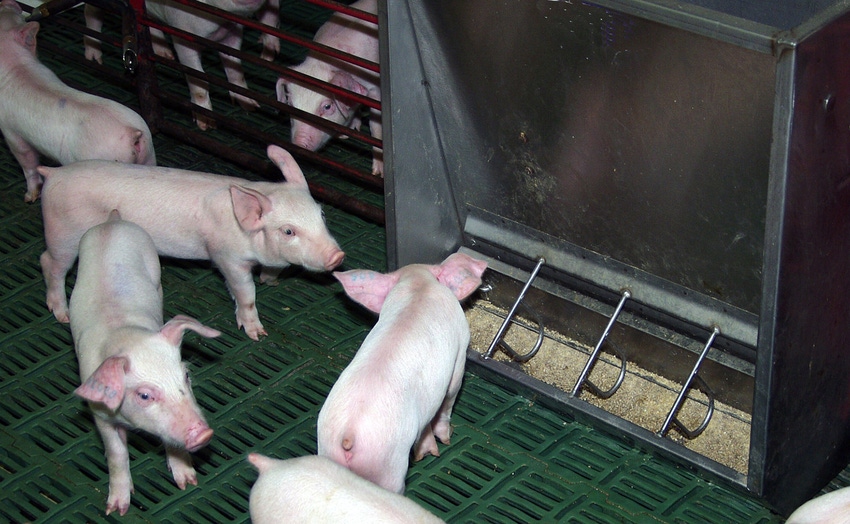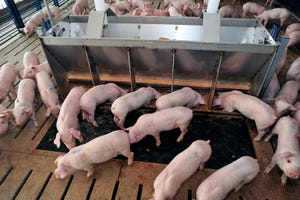Consider amino acid supplementation in diets for PRRS-affected pigs
Research has found that amino acid supplementation may benefit feed intake, gut health and immunity when disease has altered the health status of the animal.
July 14, 2022

An acute outbreak of porcine reproductive and respiratory disease is rarely seen as a learning opportunity. This was the case recently in the SDSU Research and Teaching Unit. After experiencing a PRRS break, the unit faced the dilemma of how to feed the infected pigs.
The choices being diets to promote recovery or the usual program diets – a common issue in the 30 years of PRRS. Investing more feed expense in unhealthy animals which may not recover for later marketing must be weighed against the opportunity to assist pigs in the recovery process and eventual marketing as full-market pigs.
Recent research has found that amino acid supplementation, including tryptophan, methionine, threonine, arginine and glutamine, may benefit feed intake or appetite, gut health and immunity when disease has altered the health status of the animal. The metabolism of amino acids is changed in disease which may limit needed metabolites available for critical gut health and immune function.
For example, supplemental arginine may be needed in viral infections due to increase arginase from immune activation and for cell proliferation. Arginine and glutamine are also often used in human medical nutrition as the critical components of immunonutrition formulas (Kudsk, 2006).
These selected amino acids may have therapeutic benefits if provided at higher levels for viral infections than is normally required by healthy pigs. The objective of this initial trial was to evaluate the effects of dietary supplementation of selected, therapeutic amino acids on growth performance and immune function in growing pigs with PRRS.
Two groups of pigs separated by approximately four weeks of age were transported to the Beresford, South Dakota research station for a feeding study to evaluate higher levels of amino acid supplementation in pigs with a natural PRRS infection. The pigs were allocated on the basis of weaning group, sex and body weight to 18 pens (9-10 pigs per 4 ft X 16 ft pen) and placed on one of the three dietary treatments.
The treatment diets were formulated to contain: 1) Control – corn, SBM diets meeting the NRC requirement for lysine and amino acid ratios; 2) 25% higher levels of each of the following amino acids – tryptophan, threonine, arginine, histidine and methionine (TAA); 3) 50% higher levels of those same TAA levels in Treatment 2. The pigs were fed ad-libitum for 8 weeks.
All pigs were vaccinated twice for PRRS, once on d 21 and again on d 42, to increase virus-induced immune stimulation. Pigs were treated either individually with injectable antibiotics (Exceed) or through water medications.
Body weights and feed intake was measured on a bi-weekly basis from initiation to d 56 of the trial. Plasma IgG, PRRS antibody titers and acute phase proteins analyses are pending completion. Treatments, medications and mortality were recorded.
The outcomes of this initial trial support the use that supplemental amino acids may play a role in the therapy of pigs with viral disease. Lighter weight pigs are often more severely affected by disease, so weights are expressed as totals due to the bias created in groups with higher mortality. Total weight gains and survival favored the pens fed the 25% higher level of therapeutic amino acids.
Due to the limited numbers per treatment in this study, the results on mortality should be interpreted with caution. Also, multiple amino acids were used due to the limitations in the number of pigs and pens available.
Despite the limitations of the size of the study, the initial results showing directional improvement in survival and feed conversion support the concept of the use of amino acids in a therapeutic amino acid approach to feeding pigs challenged by disease. Additional research is needed to optimize the amino acid profile, dietary levels and economics in challenged pigs.
References:
Kudsk KA. Immunonutrition in Surgery and Critical Care. Annu Rev Nutr. 2006;26:463–479
Source: Eric Weaver, Ryan Samuel and Bob Thaler, who are solely responsible for the information provided, and wholly own the information. Informa Business Media and all its subsidiaries are not responsible for any of the content contained in this information asset.
You May Also Like



